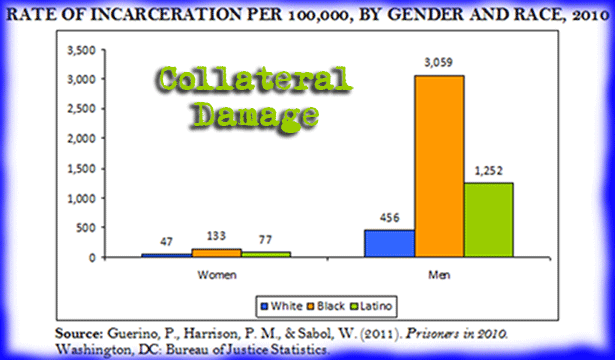
More than two decades ago, James Smith of the Rand Corporation and Finis Welch of UCLA, published what was viewed as a seminal paper about the progress made evolution of black-white inequality during the 20th century—-particularly between 1940 and 1980.
With electronic access to census and similar data, Smith and Welch found that, in most important areas—like years of schooling completed and earning power—black men were dramatically closing the gap between themselves and their white counterparts.
Now, a quarter century later, Derek Neal and Armin Rick, two economists from the University of Chicago, have just published their own report, which looks at the economic progress since 1980 when Smith and Welch left off. What they found is this: not only has economic progress halted in significant areas for black men, but in many cases it has gone backward.
The major factor driving their calculations, Neal and Rick concluded, was the “unprecedented” rise in incarceration beginning in the mid-1980’s among American men in general, but disproportionately among black men, who research showed were—and still are—treated differently, statistically speaking, by the U.S. criminal justice system.
They wrote:
Since 1980, prison populations have grown tremendously in the United States. This growth was driven by a move toward more punitive treatment of those arrested in each major crime category. These changes have had a much larger impact on black communities than white because arrest rates have historically been much greater for blacks than whites.
Further, the growth of incarceration rates among black men in recent decades combined with the sharp drop in black employment rates during the Great Recession have left most black men in a position relative to white men that is really no better than the position they occupied only a few years after the Civil Rights Act of 1965.
Neal and Rick’s paper, which you can find here, runs 91 pages and has a lot to offer on this disturbing topic, including graphs and charts, if you want additional details.
For more in a compact form, Christopher Ingraham of the Washington Post has his own quick take on Neal and Rick’s alarming news.
RECALIBRATING JUSTICE: EXAMINING THE NEWEST STATE TRENDS IN REFORMING SENTENCING & CORRECTIONS POLICY
The Vera Institute has just put out an excellent new report outlining the recent legislative changes made last year across the U.S. at a state level that are beginning to turn around the tough-on-crime trend that has had the country in its clutches since the mid-80’s. The report is designed, not just to inform, but to provide direction for states that have yet to fully embrace the practices can produce better outcomes at less cost than incarceration.
Here’s a clip from the report’s summary:
In 2013, 35 states passed at least 85 bills to change some aspect of how their criminal justice systems address sentencing and corrections. In reviewing this legislative activity, the Vera Institute of Justice found that policy changes have focused mainly on the following five areas: reducing prison populations and costs; expanding or strengthening community-based corrections; implementing risk and needs assessments; supporting offender reentry into the community; and making better informed criminal justice policy through data-driven research and analysis. By providing concise summaries of representative legislation in each area, this report aims to be a practical guide for policymakers in other states and the federal government looking to enact similar changes in criminal justice policy.
Read the rest of the summary here.
And go here for the full report.
THE EVOLUTION OF DISTRICT ATTORNEY JACKIE LACEY
We reported Wednesday on Jackie Lacey’s fact-laden, often impassioned and entirely ambivalent presentation Tuesday to the LA County Board of Supervisors regarding the necessity for a real community diversion program for a large percentage of the county’s non-violent mentally ill who are, at present, simply cycling in and out of jail.
Lacey is also a newborn champion of split sentencing for LA prosecutors, and has at least taken initial steps toward affirmative stances on other much needed criminal justice reforms, like pretrial release.
Interestingly, as those who remember Lacey’s positions on similar matters during her campaign for office are aware, it was not always so. Not by a long shot.
With this once and future Jackie in mind, a well-written LA Times editorial takes a look at the evolving views of LA’s first female DA.
We at WLA think the news is heartening. Growth and change are essential for all of us. And we admire those, like Lacey, who have the courage to become more than they were the day, week, month, year before—especially when they have to do it in public.
May it continue.
Here’s a clip from the LAT editorial.
In the closing weeks of the long and contentious 2012 campaign for Los Angeles County district attorney, Jackie Lacey fielded questions at a South L.A. church filled with activists and organizers who were advocating near-revolutionary changes in the criminal justice system. They asked the candidate: What would she do to make sure fewer people go to prison? Didn’t she agree that drug use and possession should be decriminalized? How quickly would she overhaul the bail system to make sure the poor are treated the same as the rich while awaiting trial? Would she ensure that mentally ill offenders get community-based treatment instead of jail? Would she demand so-called split sentences, under which convicted felons spend only part of their terms in jail, the other part on parole-like supervision?
Her opponent hadn’t shown up to the forum, so Lacey had the audience to herself. She could have owned it. With a few platitudes and some vague words of support, she could have had everyone cheering.
Instead, she proceeded to slowly and methodically answer questions as though she were deflating balloons, popping some immediately, letting the air slowly out of others.
Her role, she said, was not to keep people out of prison but to keep people safe. Drugs damage the users, their families and their communities, she said, and the criminal justice system should dissuade young people, especially, from using drugs. Bail is complicated, she said, but gives the accused an incentive to show up for trial.
A LOOK AT WHAT MIAMI-DADE IS DOING RIGHT WITH MENTAL HEALTH DIVERSION
In her story about Lacey’s presentation to the board of supervisors on Tuesday, KPCC’s Rina Palta took a very smart look at the much-invoked diversion strategies that the Florida’s Miami-Dade County has put in place and how they work—since, after all, it is these ideas that Lacey and her team have been studying as they work to figure out what will work for LA.
Here’s a clip:
“It really started not because we’re better than or smarter than anyone else, but because our needs are worse than anyone else,” said Steve Leifman, the associate administrative judge of the Miami-Dade criminal division and chair of Florida’s task force on substance abuse and mental health issues in the courts.
Leifman said that while the national average for serious mental illness in the population is about 3 percent, in his county, it’s 9.1 percent.
Meanwhile, Florida’s public mental health spending ranks near the bottom in the nation. (He estimates public health dollars provide enough care for about 1 percent of the population.)
The county held a summit — similar to the one held by Lacey in L.A. in May — and commissioned a study from the University of Southern Florida to look at its large mentally ill jail population.
Leifman said the results were striking.
“What they found is that there were 90 people — primarily men, primarily diagnosed with schizophrenia — who over a five-year period were arrested almost 2,200 times, spent almost 27,000 days in the Dade County jail. Spent almost 13,000 days at a psychiatric facility or emergency room. And cost taxpayers about $13 million in hard dollars,” he said.
To turn things around, the county has relied largely on federal aid, through Medicare, to fund treatment-based programs for its mentally ill misdemeanants and non-violent felons. It’s also learned to leverage local resources well by collaborating with community partners, Leifman said.
The main programs fall into two categories: pre-arrest and after-arrest.
Now for the details, read the rest of Palta’s story.
MARK RIDLEY-THOMAS AND OTHER BLACK LEADERS ENDORSE JIM MCDONNELL FOR SHERIFF
On Friday morning, Supervisor Mark Ridley-Thomas and more than a dozen notable African American leaders, including Pastor Xavier Thompson, President of the Baptist Ministers Conference, endorsed Jim McDonnell for Los Angeles County Sheriff.
“Chief Jim McDonnell has the integrity and foresight to lead the Sheriff’s Department into a new era of transparency and success,” said Ridley-Thomas. “Throughout his years of public service, he has shown that he is not just tough on crime, but smart on crime, with the insights to recognize the value of investing in prevention and crime reduction strategies that keep our community safe and also help promote more positive outcomes for those at risk of entry into the justice system.”
McDonnell told the crowd at the Southern Missionary Baptist Church in the West Adams District that he was proud to have the support of Ridley-Thomas, whom he said was “deeply committed to transparency and accountability in the Sheriff’s Department and a tremendous advocate for community engagement. I look forward to working together to find ways that we can protect our neighborhoods and help our children and families thrive.”
MRT’s endorsement means that McDonnell is now supported by all five members of the LA County Board of Supervisors.
Former undersheriff Paul Tanaka, McDonnell’s rival in the contest for sheriff, has been conspicuously quiet in past weeks, and was unresponsive to WLA’s request for comment earlier this week on the issue of mental health diversion.
Graphic at top of post from Bureau of Justice Statistics, U.S. Department of Justice


I think it is quite clear that Tanaka is toast, politically and criminally. Paul couldn’t raise enough money to buy a Grand Slammer breakfast at the MCJ ODR. His website has cobwebs, he has done nothing to advance his “In my 33 years, I’ve never allowed, participated not condoned deputy misconduct of any type. Just check my record,” tour. Perhaps he is practicing his September 8th Federal sentencing hearing speech for the Tanaka Six, where he will tell the court he’s to blame and not the patsies who have had their world rocked. Speaking of which, I wonder how many of the six will have their sentencing “delayed,” indicating they’ve seen the light and are cooperating. Maybe Candidate Tanaka will be the next to endorse Jim McDonnell. People are mighty quite around The Patio of late, had lunch there last week, found an old coin on the ground.
L.A. County District Attorney Lacey has indeed undergone a transformation in how she views her role. The changes should be welcomed.
Whenever the opportunity arises to speak again with D.A. Lacey about her evolution, let’s hear what she has to say on the impact of Thomas Goldstein.
Mr. Goldstein was convicted at trial in 1980 of committing a murder in Long Beach. The testimony of a jailhouse confession perjurer was critical to the conviction.
Mr. Goldstein served 24 years in prison until a judge ordered him freed for having been denied access to exculpatory evidence.
Goldstein sued the City of Long Beach and the Los Angeles County District Attorney. Long Beach and Goldstein reached a settlement in 2010 for $7.95 million.
Goldstein’s suit against L.A. County was s dismissed under a theory of absolute immunity for prosecutorial misconduct, however Mr. Goldstein’s appeal of that dismissal received a judgement allowing him to proceed.
The favorable appeals court ruling specifically addresses and defines the role and duties of the District Attorney.
Lets hear what D.A. Jackie Lacy has to say about Thomas Goldstein.